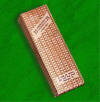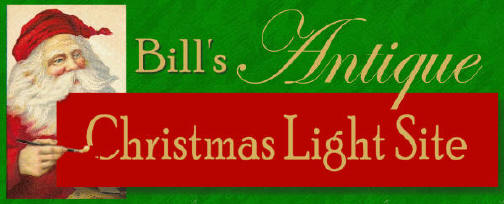|
The 1950s saw the beginning of the end of America's love/hate
relationship with the ubiquitous C-6 series wired miniature base
Christmas light bulb. The majority of American homes used this type of
lighting string due to their very low cost, but the "if one goes out
they all go out" characteristic could be unbelievably frustrating.
Parallel wired C-7 lamp strings with their independent burning
candelabra base lamps were much more popular now, but their high heat
and the fact that most household electrical circuits could only support
six strings of seven lamps on a tree was a decorating hindrance, and
America was ready for something new in decorative Christmas lighting.
This page will show some of the alternatives to the "standard"
Christmas lights that Americans had grown up with...
| Here is a hard to find set of
Flik-A-Lites produced by the Shunt Lamp Corporation in about 1956. The
set consists of 18 lights along with two ballast lamps shaped like
stars. The set is wired so that half of the lights will flash on and
off alternately with the other half, while the ballast lamps belonging
to each half glow brighter and dimmer as the lights flash. Provided
with the outfit were two extra ballast lamps. The bulbs are miniature
base tubular shaped, and are colored with transparent lacquers in
various colors. The lacquer type paints were not particularly durable,
and scratched and peeled easily. |

|
| Here is an early example of what were
first called "Fairy Lights". First produced in Italy by Sylvestri and
other companies, the miniature light sets like these were the beginning
of the solution to many of the problems that had frustrated Yuletide
decorators for years. The tiny lamps, which drew little current, were
offered in strings of 35 lamps, and contained shunt devices so that the
failure of a lamp or two would not cause the entire string to go dark.
The set pictured here is of Japanese manufacture, and a look at the
close-up picture will show that the lamps were NOT replaceable in the
string! Each tiny lamp was hand made, and then hard wired into the
string. While the failure of one or two lamps was not a problem, when
more than that began to fail it would hasten the death of the remaining
lamps due to the steadily increasing voltage they were receiving. It
was apparent that a way would have to be found to correct this serious
design deficiency. Additionally, the hard wired lamps and extremely
thin wiring used in these sets did not meet Underwriter's Laboratory
testing standards, and the outfits were therefore not UL approved. Many
retailers of the time would not sell non-approved outfits. The set is
circa 1958. |


|
| Here's the next step in the evolution of
the "fairy lights". This Italian made set by Sylvestri uses slightly
heavier gauge wires and protective plastic bases at the lamps to help
with durability. But the lamps are still not replaceable, and also note
that the lacquers used in coloring the lamps are flaking badly. These
lights are from the Chris Cuff collection, and date to the very late
1950s. |

|
| Also from the collection of Chris Cuff,
this set of fairy lights was made in Italy, and shows the dramatic
change from the wildly colorful boxes Americans were used to. Instead
of heavy cardboard, fold up flaps and extensive lists of features, the
Italian lights were offered in plain-Jane type boxes, with little
information or instructions. The set is not UL listed, and is a string
of 35 permanently wired lamps. Late 1950s. |

|

|
| This set is from the collection of Chris
Cuff, and is by Amico, a division of NOMA Lites. Made in 1958, the
outfit is of Japanese manufacture, and has tulip style reflectors
surrounding the permanently attached lamps. |

|
| Also from the collection of Chris Cuff,
this set of Italian lights from Ferrari is from 1959 and retains both
the original box and warranty card. This is a 35 light set with
permanent lamps and clear flower type reflectors. |

|

|
| A typical 35 light Italian set from the
late 1950s, featuring clear flower type reflectors and permanent lamps.
Notice the two misspellings on the box cover: the lack of the word
Italian being capitalized, and the "h" missing from the word Christmas.
From the collection of Chris Cuff. |

|
| This outfit from Imperial has typical
1950s colored flower shaped shades, but includes a sliding green
colored bead under each lamp to facilitate positioning on the tree
branches. Formerly a NOMA held patent, their rights to it had long
since expired and the invention was now open for all to use. This light
set also uses the "new" screw base replaceable lamps, which was
beginning to be offered on the Italian-type lights. Instead of having
to throw away the whole string of lights when the lamps failed,
consumers could now easily replace burnt out lamps, just like in the
"old days"! |

|
| Circa 1955, this NOMA "Safety Plug"
outfit was quite an innovation for its time. The wall plug contained
two fuses, which not only protected the string of lights, but also
protected all additional light strings plugged into it. Most Christmas
light sets today still use this "fuse in the plug" method of protecting
the sets. NOMA introduced this method first, in 1951. |

|

|
| From the collection of David Neely, here
is a house brand set of lights, made in Japan for Napco. These
permanently wired lights are configured in two festoons, each with its
own flashing ballast lamp. The two festoons flash on and off
independently, for a twinkling effect. Strangely, the light set is
called "TwinkleStar", but the shades over the lights are actually bell
shaped. A most interesting outfit
from the late 1950s. |
 |
 |
BACK NEXT
|


































